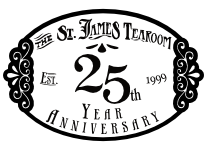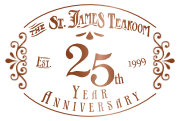
Coming to Tea

Guidelines for Parties with Children

In our continuing effort to provide each guest with an enjoyable experience, we have set some policies and guidelines for groups that include children.
- We do not allow children under the age of 4 to attend teatimes. This is a difficult environment for small children, so please arrange for a sitter for any children under age 4 so that you can relax and enjoy your full two-hour tea experience.
- We can only accommodate for children ages 4 – 10 with our Children’s Menu. Children ages 11 and up will receive the full Adult Menu.
- Parties including children ages 4 – 10 are seated only in the Library. Please accompany your children if they leave the table for any reason.
- Adult to child ratio: For every two children in your party (ages 4 – 10), there must be one adult.
- An adult must be present at any table where there is a child (regardless of age). Adults and children cannot have separate tables.
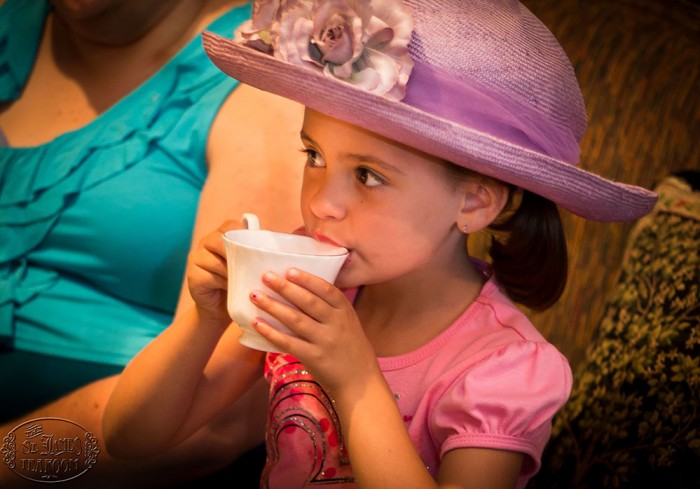
Are Your Children Ready to Come to the Tearoom?

We love to see children at the tearoom, and most often parents have already worked with their children, preparing them for the experience. Once in a while, we see parents who are beside themselves, embarrassed, and not enjoying the experience they have paid for because their children are unprepared.
Coming to the tearoom is a great opportunity for parents to teach their children courtesy to others, propriety, and etiquette. It is a teaching tool with positive incentive for their children to learn, since so many consider coming to tea a treat. So, we should address the question “How do I prepare my children to come to the Tearoom?”
It is appropriate and helpful to use every opportunity we can to teach our children proper behavior. We all want to see our children grow up to be solid, mature, and gracious adults, who are adept at working with others. We know “people skills” are most necessary when looking for a good job and this is exactly what courtesy entails: People Skills.
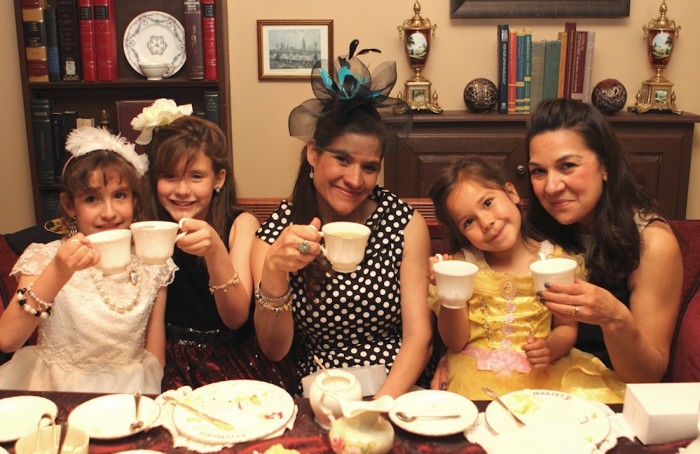
Any party with a child aged 4 – 10 will be seated in the Library as we’ve found young children’s voices carry too much in the Nooks and other groups are often disturbed. An adult must accompany any child aged 4 – 10 if they go to the bathroom or gift shop. The Tearoom is a large building and children can get lost or become otherwise distracted.
When I teach my Children’s Etiquette classes, the main thing I want every child to remember is this: “I Am Not the Only One.” This phrase encompasses a world of wisdom.
When we are immature children, we believe we are the center of the universe, and that everything should revolve around us. We are selfish. As we mature we begin to understand the worth of others and we learn to restrain ourselves in many ways so others may have opportunity to express themselves, as well.
This is the basic foundation of Civilization (which word comes from the Latin ‘civitas’, which means ‘city’ or ‘community.’) If we are to live as people in community, working and living together, we must understand and accept that we are not the only ones; we must take each other into account and make room for each other. This is a vital, basic thing to teach our children, extremely beneficial for them as they mature into responsible, capable adults.
These are the things I think your children need to know before they come to the tearoom:
- Do they understand yet that they are ‘Not the Only One’?
- Do your children exhibit awareness of and concern for others?
- Do your children know how to keep a voice and tone that are respectful to those around them? (Using an “inside voice”)
- Do they have enough body control to stay still and handle breakable objects? (This is something each parent will need to discern about each of their children, because some children take longer than others to gain this body control. Sometimes girls get to this stage before boys, but not always. Each child is different and matures in this way at different rates.)
- Do your children exhibit respect for other people’s property?
- Can your children sit still for two hours?
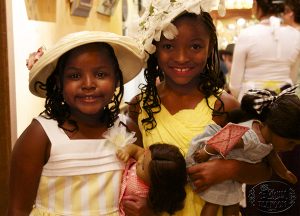
One way to use the tearoom experience to grow your children in the development of their People Skills and help them become more mature, respectful, and polite is to practice at home. Plan a time to ‘Take Tea Together,’ promising a trip to the tearoom once the skills are learned. Get out your good, breakable china and teach them how to handle the cup and saucer, how to use the sugar tongs and where to put their spoon and spreader once used. Keep some of our frozen Cream Scones on hand and bake some fresh and hot for your tea together. Children love our scones and will gladly learn how to open them and spread jam inside.
Teach them to care about others around them by modulating their voices and controlling their actions. Teach them how to take turns in conversation, to listen to others and not interrupt. Teach them the concept of ‘Civitas’, that they are Not the Only Ones. Practicing is fun when it is a party and good food is involved.
Besides the more basic and important skills of restraining oneself out of concern for others, here are some etiquette tips and exercises to use with your children:
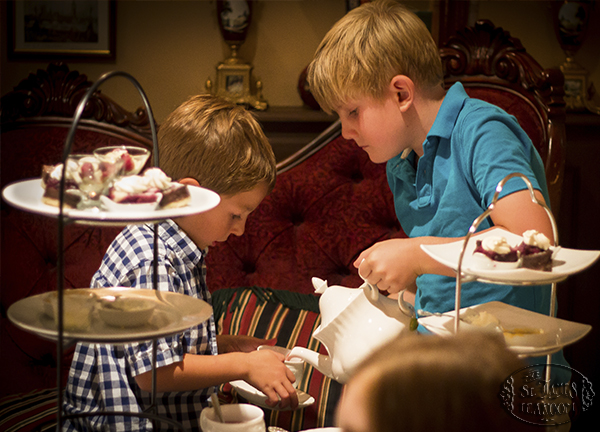
- Tea foods are finger foods. It is okay to pick up an item with their fingers, but they should only touch the one piece they intend to put on their plate; never to touch someone else’s food. If a piece of serving flatware is offered, they must use it, NOT their fingers.
- Serving spoons should never touch your food, since they will be used by others. Teach your children how to put the curd and clotted cream (or the jam and butter) on their plate, rather than their scone. Show them how to use the little spreader to then transfer these delightful additions to their scone.
- Show them how to gently tear their scone apart in two pieces, so they can more easily get it into their mouths.
- Teach them to always put a used spoon or piece of flatware on their saucer or plate, never to put it back on the table.
- Show them how to place the napkin on their laps, and how to use it.
- Teach them how to pour tea into their teacups, using two hands, one to hold the teapot handle, and the other to hold the lid.
- Show them how full to fill the teacups – never more than ¾ full, so there is room for milk and for stirring the tea without spilling.
- Teach them to watch for others’ empty cups, and to offer to fill them first, before they fill their own.
- Show them how to use sugar tongs: to pinch the lump and gently release it just above the cup, not so close the tongs get wet, and not so high as to cause a splash when it falls into the tea.
- Teach them how to set a table, where to put the flatware and the glassware, and even the more formal bread plate and spreader. Help them understand how to use their flatware “from the outside in” and how this makes sense as you eat the meal (“the salad fork is on the outside because you are usually served a salad first, before the meat dish…”)
- Practice “making conversation.” Teach them how to listen to others, how to show interest by their words and facial expressions. Give them ideas for conversations they can take part in, subjects your children know they can talk about well. Show them how to speak up with confidence, but how to also be aware of the noise level the conversation is generating. Tell them that interrupting others is just like someone shoving you out of line and taking your place.
- Here is a fun exercise to practice listening: sit together in pairs. One person will speak one sentence to his or her listening partner. The partner then must say back to the speaker exactly what was said. “You said,” and then attempts to repeat exactly what the speaker said. Reverse roles. Next, one of the partners describes something that happened to them this past week or month. It should be about a paragraph long, if it were written out. The assignment for the listener is to choose ONE WORD that describes the feelings of the speaker. “You feel ______.” Only one word, without explanation. Then reverse roles. (This is a good exercise for husbands and wives, too.)
- Make your children aware of the feelings of others. As you are out and about, watch others, and see if you can help your children “read” what is happening to them. “How do you think that lady made this clerk feel?” “How would you have felt if that had happened to you?” “Look at those children over there. What do you think is happening? Why?”
The tearoom is simply one of many venues for training your children in the vital arts of getting along well with others, of unselfish living, of living in community. We have our children for such a short time, and training them in People Skills is necessary to their future success, and to the continuation of our own ‘Civitas.’ Civilization is both ‘taught’ and ‘caught’, and mainly passes from parent to child, one family at a time. We parents have a mighty role to play! Let’s use every opportunity we can.
Yours for a return to grace, civility, beauty, gentility, and excellence, in young and old alike,
Mary Alice Higbie

